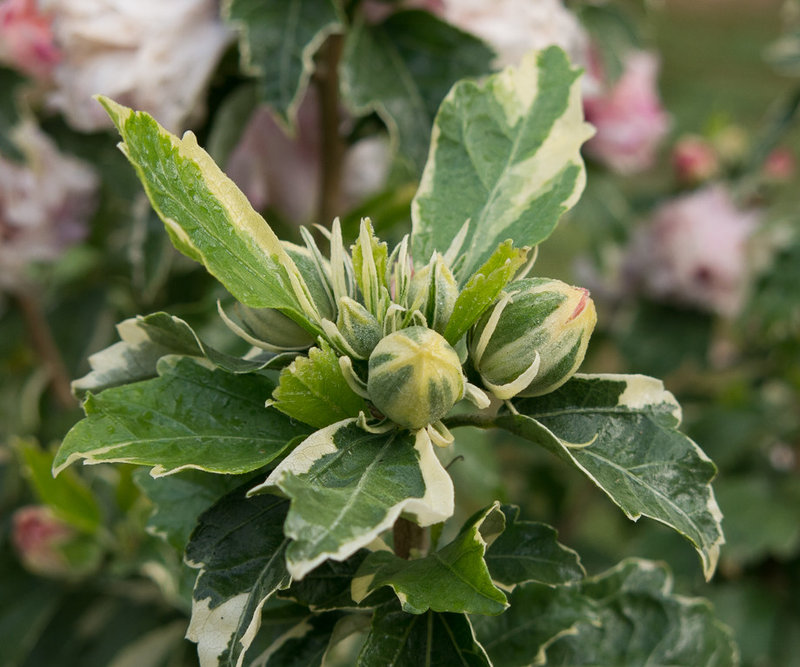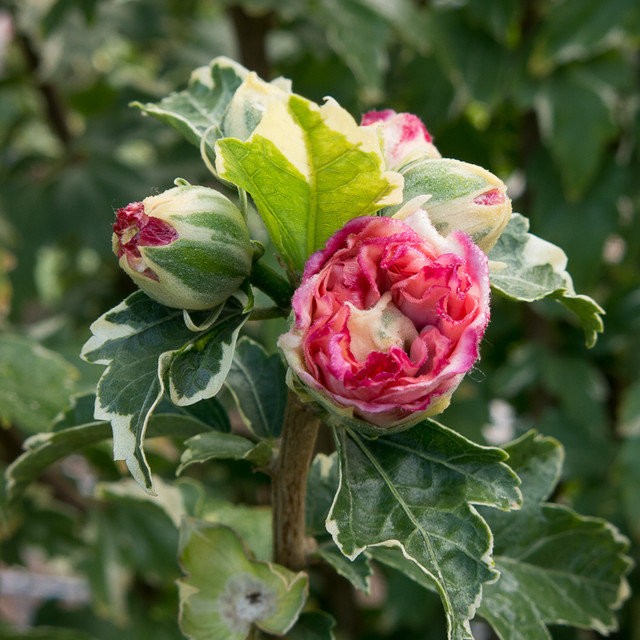The delicate, soft green and creamy-white variegated foliage is clean and healthy looking, while the abundant ruffled, double pink flowers are as pretty as a party dress. Each bud is covered in tiny white hairs, giving the appearance of being encrusted with coarse sugar granules. As the buds begin to open, they reveal a hint of deep pink. When fully open the flowers show off their layers of midpink before fading to a lighter shade, giving the whole bush a multihued effect. How could you possibly resist?
 Le jardinet
Botanical name: Hibiscus syriacus ‘Sugar Tip’
Le jardinet
Botanical name: Hibiscus syriacus ‘Sugar Tip’Common names: Sugar Tip rose of Sharon, Sugar Tip hibiscus
Origin: This species is native to Asia (not Syria, as one might expect), but Sugar Tip is a garden hybrid.
Where it will grow: Hardy to -20 degrees Fahrenheit (USDA zones 5 to 8; find your zone)
Water requirement: Average
Light requirement: Full sun
Mature size: 8 to 12 feet tall and 4 to 6 feet wide
 Le jardinet
Benefits and tolerances: Tolerant of most soil types except very dry or very wet soil; deer resistant; attracts butterflies and hummingbirds; noninvasive
Le jardinet
Benefits and tolerances: Tolerant of most soil types except very dry or very wet soil; deer resistant; attracts butterflies and hummingbirds; noninvasiveSeasonal interest: Spring to fall
When to plant: Spring or fall
 Le jardinet
Distinguishing traits:
Le jardinet
Distinguishing traits:- Variegated foliage
- Ruffled pink flowers
- Abundant blooms
- Smaller than many older varieties
 Le jardinet
How to use it. The upright growth habit lends well to containers as a large shrub or small tree. In a big pot, it could be underplanted with soft pink million bells and silver falls (Dichondra argentea ‘Silver Falls’) for a feminine look.
Le jardinet
How to use it. The upright growth habit lends well to containers as a large shrub or small tree. In a big pot, it could be underplanted with soft pink million bells and silver falls (Dichondra argentea ‘Silver Falls’) for a feminine look.Sugar Tip would also make an attractive specimen plant in the landscape, in a mixed border of perennials and shrubs or even as a hedge if spaced 6 feet or so apart.
Planting notes. Hibiscus blooms on new wood, so do any pruning in early spring before the new growth begins. It can be pruned hard to keep it smaller.
Use a slow-release fertilizer for trees and shrubs in early spring. I also watered mine with Moo-Poo teatwo or three times during the summer.
Where to buy. Many nurseries carry Sugar Tip; give us a call at The Masters Lawn Care 352.378.5296 and we would love to go over a landscape design and get you started on your summer yard project.
